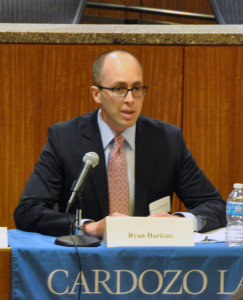Summary of Ryan Harkins’s presentation in a panel on “Disclosure and Notice Practices in Private Data Collection” at Data Privacy & Transparency in Private and Government Data, April 4, 2014 at Benjamin N. Cardozo School of Law.

In addition to making visiting more websites possible, advances in technology have made collecting data from visiting all those websites possible. Further, advances in technology have meant the ability to analyze that data in ways beyond the imagination of researchers, with computers catching on to trends in data that people may have never noticed.
It’s all a part of “big data,” which is basically the ability to store and process massive amounts of data at rapid speeds, according to Ryan Harkins, Privacy Attorney at Microsoft. Advances in computing have allowed machines to draw insights or identify correlations that may not have even been contemplated at the time of data collection.
And with the advent of the internet of things, “there’s been an explosion in the amount of data that’s being collected about each and every one of us,” Harkins said.
Currently, the collection and use of this data is done under the guidance of the Federal Trade Commission’s Fair Information Practice Principles (“FIPPs”), which are designed to ensure that data about individuals is processed fairly while maintaining some level of privacy for the user.
At the heart of the FIPPs is consent, Harkins said, but the notice and consent model has been weakening over time. The current regime places the burden on individuals, who are expected to read, understand, and make informed decisions on complex data activities. “It’s become exceedingly difficult for individuals to do,” Harkins said.
According to Harkins, the key is striking the proper balance between informing users of the important issues, but not overwhelm them. “On the one hand, you want to be clear and comprehensive, but you want to be comprehensible and precise on the other,” he said.
But while big data has tremendous promise for societal benefit – an analysis of how email spammers mutate their algorithms to stay ahead of filters helped a study map the mutation of HIV – it also threatens to obliterate the notice and consent model altogether, Harkins said.
Harkins offered several ideas on how to unlock the potential of big data while providing privacy protection for individuals, including strengthening and adapting the notice and consent model, bolstering other principles in the FIPPS (for example, better security, transparency, and integrity requirements), and even using technology as the solution to the problem technology has created.
For more from this panel, click here.




[…] Ryan Harkins – Big Data Means a Change in How We Consider Notice and Consent […]